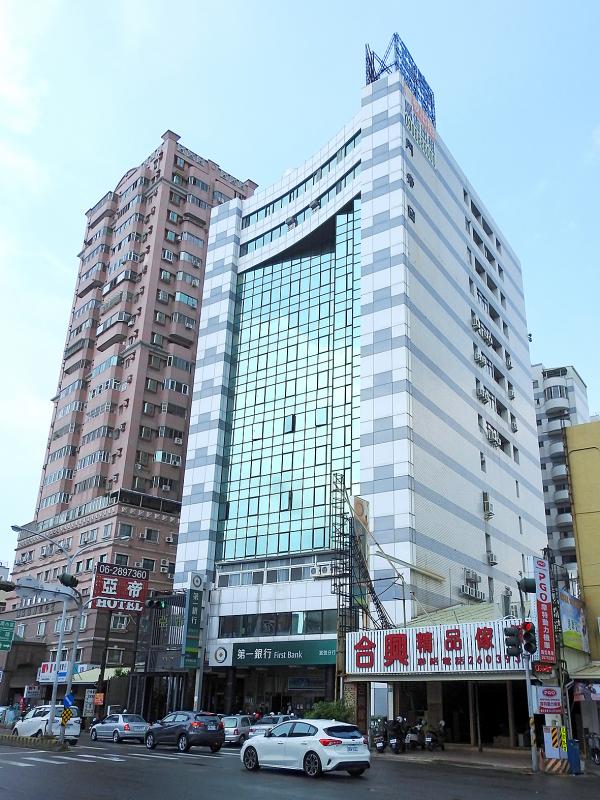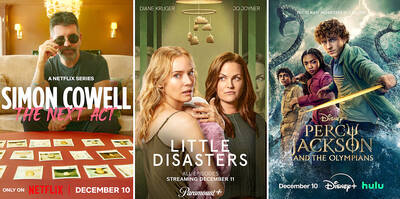Taiwan’s cities are characterized by densely populated neighborhoods. From an environmental perspective, this is a blessing for the country — and not just because it leaves more space for farms, woodlands and nature reserves.
There are certain efficiencies when people live in dense communities. Journeys to work and to shops are shorter, and citizens are more likely to walk or use public transportation. Recycling rates are higher; garbage is usually properly collected and processed.
On the other hand, because landscapes dominated by concrete and tarmac retain heat long after the sun has gone down, city dwellers make greater use of airconditioning compared to folks in the countryside.

Photo: Steven Crook
Several districts in Taipei and New Taipei City, and a few in Taichung and Kaohsiung, have more than 20,000 residents per square kilometer. According to household-registration data, Taiwan’s most densely populated local government subdivision is New Taipei City’s Yonghe District (永和) with an average 38,185 people per square kilometer. Some cities on the Indian subcontinent are even more crowded.
SKYSCRAPER EXPLOSION
The appearance of Taiwan’s cities has changed hugely in the past three decades, in many ways for the better. Also, since the early 1990s, buildings over 150m in height have begun to dot the skylines of Taipei, New Taipei, Taichung and Kaohsiung.

Photo: Steven Crook
A Feb. 26 op-ed on the United Daily News Web site attributes the proliferation of tall buildings to the government’s 2018 decision to scrap EIA (environmental impact assessment) requirements for buildings under 120m (one story is equal to 3.3 meters).
“The number of skyscrapers in Kaohsiung has suddenly increased in recent years… In the past three years, Kaohsiung has gained 29 high-rises, the highest of which has 46 floors,” it says, while also pointing out that dense clusters of skyscrapers are a hazard to migrating birds.
Skyscrapers might be a symbol of modernity, but it’s difficult to argue that they belong in a sustainable city. Researchers on different continents have concluded that tall buildings are far less efficient per square meter of floor space than structures no more than five stories high. This is true for the carbon emissions generated by manufacturing and transporting the materials used in the building’s construction, and for the energy it consumes during its lifetime.

Photo courtesy of Wikimedia Commons
One reason for this is that high-rise buildings’ foundations must support exceptional vertical and lateral loads.
The former depends on the building’s height. Because calculations of the latter are influenced by the likelihood of earthquakes and typhoons, a skyscraper in Taiwan is likely to incorporate more steel and concrete than a building of identical height in London or Paris. It goes without saying that, for a tower like Taipei 101, the amount of “embodied energy” — energy consumed whether the building is fully utilized or not — is huge.
In cool climates, freestanding tall buildings lose heat rapidly. In warmer places like Taiwan, they’re baked by the sun.
A study of 611 office buildings in England and Wales, published in 2018 in Building Research & Information (BRI), found that in high-rises with 21 stories or more, compared to buildings with no more than five stories, mean intensity of electricity and fossil fuel use was 137 percent higher and 42 percent higher, respectively. (In the UK, many buildings are heated by gas or oil.)
How much energy a high-rise uses depends in part on its surroundings. Generally speaking, the taller the building, the more exposed it is to the elements. However, the blocking effect of high-rises nearby may reduce solar heat gain.
Office buildings typically have large windows, and daylight reduces the need for artificial lighting. Unfortunately, even the best thermal-insulation glass is far less effective than an ordinary wall at blocking heat gain in the summer and retaining warmth during the winter. As the authors of the BRI study put it, savings that result from additional daylight “may be outstripped by factors that increase electricity and fossil fuel use, such as an increased demand for cooling or mechanical ventilation associated with solar gains.”
Elevator use is another factor. Elevators account for between 2 percent and 10 percent of a high-rise’s total energy consumption, according to a 2015 paper by Kheir Al-Kodmany of the Department of Urban Planning and Policy, University of Illinois at Chicago.
Al-Kodmany points out that new elevators are considerably more efficient, thanks to technologies like regenerative drives. As in hybrid cars, these harness the energy from breaking. Heavy steel ropes are being replaced with carbon-fiber ropes which weigh just one tenth as much. One consequence of these breakthroughs, however, is that architects now dream of building structures even taller than the 828m-tall Burj Khalifa.
GREENING SKYSCRAPERS
The authors of the 2018 BRI paper note that the data they collected suggests “achieving low-carbon performance in tall buildings is possible. However…this is rarely achieved.”
Taipei 101 may well be one of the exceptions. The tower’s official Web site says it’s been “internationally certified as the world’s tallest green building since 2011.”
The 508m-tall structure has had several sustainable-architecture features from the outset, such as a rainwater capture system. Its owners sought and in 2016 obtained LEED v4 Platinum certification.
LEED is an American system for assessing the environmental impact of individual buildings; Platinum is the highest possible ranking.
According to SmartCitiesDive.com, the building’s power consumption dropped 18 percent between 2007 and 2010, and “energy and water consumption at Taipei 101 are now 30 percent below averages for comparable properties.”
Those final three words are significant, of course. Because precise electricity and water usage totals aren’t available, it’s possible that Taipei 101 is still something of a resources black-hole, compared to conventional office buildings.
Taipei 101’s Platinum certificate was renewed on July 23 — and at least it’s a bustling place.
By contrast, Kaohsiung’s 347m-tall 85 Sky Tower (高雄85大樓) — Taiwan’s no. 2 building in terms of height, and the 69th-tallest building in the world — has been chronically underutilized for most of its 22-year existence. In recent years, several units have been illegally converted into B&Bs.
Given Taiwan’s land shortage, building upward is unavoidable. But given the vast number of empty houses, apartments and office suites across the island, the authorities should put a brake on high-rise construction projects, unless they meet the strictest sustainability standards.
There’s a lot to be said for the prosaic four and five-floor walkups that dominate much of urban Taiwan. Now if only there was a rooftop garden or a photovoltaic arrays on top of each one.
Steven Crook, the author or co-author of four books about Taiwan, has been following environmental issues since he arrived in the country in 1991. He drives a hybrid and carries his own chopsticks. The views expressed here are his own.

As I finally slid into the warm embrace of the hot, clifftop pool, it was a serene moment of reflection. The sound of the river reflected off the cave walls, the white of our camping lights reflected off the dark, shimmering surface of the water, and I reflected on how fortunate I was to be here. After all, the beautiful walk through narrow canyons that had brought us here had been inaccessible for five years — and will be again soon. The day had started at the Huisun Forest Area (惠蓀林場), at the end of Nantou County Route 80, north and east

Specialty sandwiches loaded with the contents of an entire charcuterie board, overflowing with sauces, creams and all manner of creative add-ons, is perhaps one of the biggest global food trends of this year. From London to New York, lines form down the block for mortadella, burrata, pistachio and more stuffed between slices of fresh sourdough, rye or focaccia. To try the trend in Taipei, Munchies Mafia is for sure the spot — could this be the best sandwich in town? Carlos from Spain and Sergio from Mexico opened this spot just seven months ago. The two met working in the

Exceptions to the rule are sometimes revealing. For a brief few years, there was an emerging ideological split between the Democratic Progressive Party (DPP) and Chinese Nationalist Party (KMT) that appeared to be pushing the DPP in a direction that would be considered more liberal, and the KMT more conservative. In the previous column, “The KMT-DPP’s bureaucrat-led developmental state” (Dec. 11, page 12), we examined how Taiwan’s democratic system developed, and how both the two main parties largely accepted a similar consensus on how Taiwan should be run domestically and did not split along the left-right lines more familiar in

A six-episode, behind-the-scenes Disney+ docuseries about Taylor Swift’s Eras Tour and Rian Johnson’s third Knives Out movie, Wake Up Dead Man, are some of the new television, films, music and games headed to a device near you. Also among the streaming offerings worth your time this week: Chip and Joanna Gaines take on a big job revamping a small home in the mountains of Colorado, video gamers can skateboard through hell in Sam Eng’s Skate Story and Rob Reiner gets the band back together for Spinal Tap II: The End Continues. MOVIES ■ Rian Johnson’s third Knives Out movie, Wake Up Dead Man